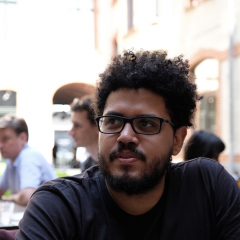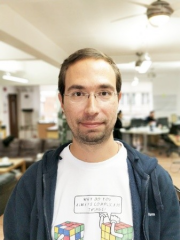Session + Live Q&A
How SeatGeek Successfully Handle High Demand Ticket On-Sales
High-demand online ticket on-sales are a core part of SeatGeek’s business and pose a challenge to delivering a seamless user experience. SeatGeek's ability to handle large amounts of online traffic made the company the preferred ticketing solution for significant teams at the English Premier League. They use SeatGeek’s primary ticketing software, SeatGeek Enterprise, to give supporters a best-in-class buying experience.
For example, the high demand for tickets in a UEFA Champions League Final translates into very high traffic surges on our ticketing platform. Our ability to handle this load has a lot to do with our usage of virtual waiting rooms or online queuing systems. They can help protect a website’s overall user experience by remaining online for a subset of users while the excess traffic is queued (First-In-First-Out). Also, virtual waiting rooms can be applied when the desired feature is that the user should wait their turn to access a protected area of a website.
You will learn how our ticketing systems work and get a deeper understanding of our in-house virtual waiting room – the primary component that allows us to handle these high-traffic ticket on-sales. We will show details of its implementation using Golang and Javascript, both deployed on AWS and Fastly infrastructure.
Main Takeaways
1 Hear about how SeatGeek handles high demand traffic.
2 Learn how to deal with spikes in traffic, to keep sanity in the operations team.
What is the focus of your work these days?
Vitor: I'm working with the cloud platform team. We're providing the platform that every SeatGeek engineer uses to do their work. So we take care of all the aspects of compute, network storage and also things such as the developer tooling.
Anderson: I'm working with the app platform team. We’re working to reduce the amount of time that operators are adding to operate large on-sales. We built our virtual waiting room solution, it is running on production. Now I am working on integrations to achieve the set-and-forget goal.
And what is the motivation behind your talk?
Vitor: We had a lot of learnings throughout this process, we went from using internally built solutions, using externally built solutions, and then we arrived at what actually allows us to run large events, think about the English Premier League. Very famous match. That's the thing that actually allows us to run those types of events and we'd like to share the learnings and then all the things that we discovered and developed along the way.
Anderson: The total of available tickets is limited by the capacity of stadiums/theaters. It causes racing conditions in large on-sales and we work to deliver the fairest way for users purchasing tickets. That is, the user that arrives earlier must have the opportunity to buy tickets earlier (First-In, First-Out). We have successfully executed on-sales using our virtual waiting room solution, it absorbs a high traffic and pipes it to a constant traffic in our infrastructure. It helps to keep our systems up and running.
How would you guys describe the persona and level of the target audience for your session?
Vitor: I think people that are no stranger to the problem of running in highly concurrent environments. I would imagine people that are more the lead engineer, architect people in their companies. I would imagine that would be the people that would benefit the most from the talk.
Anderson: People that are operating apps/infrastructures that receive high traffic. Scaling is always a good thing for a web app, but it can also be a pain point. How can you be sure you can handle more traffic than you currently have? I would like to show how a virtual waiting room solution helps to protect applications against unpredictable high traffic.
And what is it that you guys would like this persona to walk away with after watching your session?
Anderson: How to combine stateless solutions running on the Edge with stateful solutions running on the backend. This combination should provide the best experience for users in terms of latency. It reduces the request round trip and helps systems to have a healthy state.
Vitor: To sum it all up, attendees understand how they can cope with very spiky workloads in a way that you can reason about, that you can reduce the stress in the people operating the system. That's one of the architectural patterns that we are using. And we hope that people get away from this from this presentation knowing how to apply what they have learned.
Speaker

Anderson Parra
Senior Software Engineer @SeatGeek
Ander is a software engineer with many years of experience in large distributed systems that support high-traffic and huge volumes of data. He has created solutions using Java, Scala, JavaScript, Ruby, Python and Golang for companies in Brazil, Ireland, Germany, UK, and US. He has a master's...
Read moreSpeaker

Vitor Pellegrino
Director of Engineering @SeatGeek
Vitor Pellegrino is a Director of Engineering at SeatGeek. He leads the Cloud Platform team, which is the group responsible for developing the platform that powers all SeatGeek's systems. He has been working as a software developer for over 15 years with companies in Brazil, Germany and...
Read moreFind Vitor Pellegrino at:
From the same track
Large Scale Architectures Panel
Monday Apr 4 / 05:25PM BST
Join Eder Ignatowicz of Red Hat as he explores architectural issues with a panel of experts from some of the world's largest architectures.

Sarah Wells
Former Tech Director for Engineering Enablement @FT (Financial Times)

Vitor Pellegrino
Director of Engineering @SeatGeek

Anderson Parra
Senior Software Engineer @SeatGeek

Bart de Water
Manager @Shopify Payments Team
Unconference: Architectures You've Always Wondered About
Monday Apr 4 / 11:50AM BST
Details coming soon
Scribe: The 15-Year Evolution of Meta’s Data Transport Service
Monday Apr 4 / 04:10PM BST
Meta's hardware infrastructure comprises millions of machines, all of which generate data. The overall traffic generated reaches several petabytes every hour, while its processing typically takes place somewhere other than where it was originally generated. The task of collecting,...

Manos Karpathiotakis
Software Engineer @Meta

Vlassios Rizopoulos
Production Engineer @Meta
Shopify’s Architecture to Handle the World’s Biggest Flash Sales
Monday Apr 4 / 02:55PM BST
How do you enable millions of entrepreneurs to run their businesses on your platform? And how do you deal with product launches that suddenly bring millions of requests per minute from one moment to the next?This talk will walk through how Shopify works under the hood using the customer journey...

Bart de Water
Manager @Shopify Payments Team
How Starling Built Their Own Card Processor
Monday Apr 4 / 10:35AM BST
Rob Donovan and Ioana Creanga talk about what happens behind the scenes when you pay with your card, and how Starling built their own card processor, integrating more traditional hardware with cloud-deployed micro-services.

Rob Donovan
Tech Lead @StarlingBank

Ioana Creanga
Engineer Lead for the Payments Processing Group @StarlingBank

